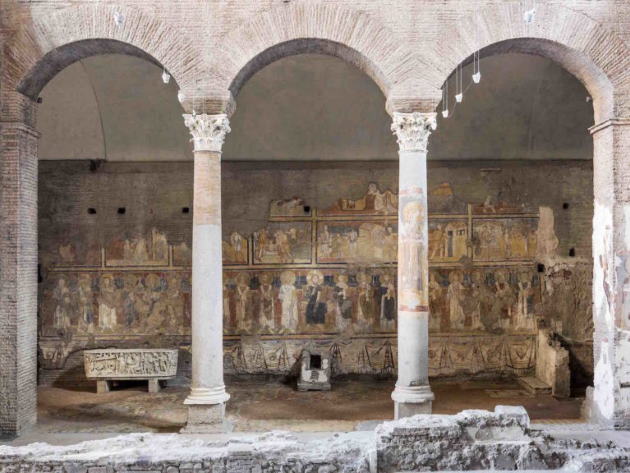
A hidden treasure, brought back to light in 1900: located on the slopes of the Palatine hill, the church of Santa Maria Antiqua is the earliest and most significant Christian monument within the Roman Forum. It was founded in the mid-6th century in what was once part of a monumental architectural complex dating to the reign of Domitian and preserves a unique collection of wall paintings that make it a “museum” of Roman painting during the centuries in which the influence of Byzantium on Rome was stronger. The church was abandoned after its collapse in an earthquake in 847: on top of the ruin, a new church was built in the 13th century, renamed Santa Maria Liberatrice and restored in the Baroque style to a design by Onorio Longhi. This was demolished in 1899 to uncover the remains of the older church.
The church has a central nave and side aisles, with two small chapels on either side of the presbytery. Inside the church are still visible about 250 square meters of frescoes, dating from the 6th to the 9th century. The surviving frescoes are the result of several different projects, and the newer ones were often painted on top of the older, as shown by a wall, where they are layered to form a “palimpsest”. Here six layers of painting can be identified: the image of Our Lady, holding the Christ-child and depicted as an enthroned Roman empress, dates back to the first phase of the church; the Annunciation featuring the so-called “Beautiful Angel” dates back to the 7th century. Particularly well preserved is the cycle of the martyrdom of St. Cyricus and St. Julitta, which almost entirely covers the chapel of Theodotus, dating from the papacy of Pope Zacharias (741-752). The chapel on the right of the presbytery is dedicated to the Medici Saints. In the left aisle there is a row of saints of the Greek and Latin Church, with Christ at the center, surmounted by stories from the Old Testament.
Next to the entrance of the church, the entrance hall to the monumental Domitian Ramp, that led from the Forum to the Imperial Palaces on the Palatine, was transformed with the Christianization of the Forum into an Oratory. The chapel was dedicated to forty Christian soldiers condemned to die in the icy waters of a lake at Sebaste in Armenia, during the imperial persecutions at the beginning of the 4th century AD. The episode is represented in a large frescoe dating back to the 8th century. The interior is quadrangular. On the right-hand wall it also has a fresco of St. Anthony the Hermit, while the floor preserves fragments of marble paving from the Middle Ages.
Information
1-26 March and 1-29 October > 9.30-16.45 (last admission at 16.15)
27 March - 30 September> 9.30-18.30 (last admission at 18)
30 October - 28 February > 9.30-15.45 (last admission at 15.15)
 Condividi
Condividi
Location
To find out about all accessibility services, visit the Rome accessible section.











































